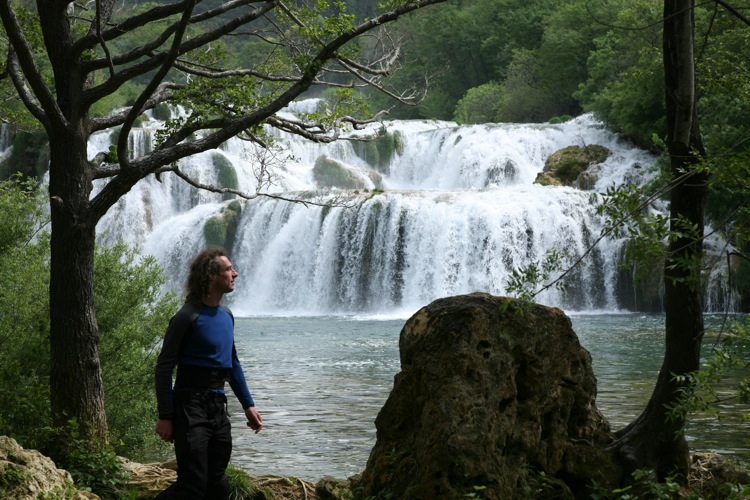Croatia, Europe

History began right here, in a simple narrow house in the village of Kumrovec, with doors so low I have to duck every time my 6'2" frame enters a room. I'm at the birthplace of half of Eastern Europe's former ruler, Josip Broz, better known as Tito. He held together with ambition and skill, the powers of socialism, until it finally collapsed in an absurd war, where neighbors were against neighbors and brothers against brothers. His country was called Yugoslavia — but it's gone now.
Remnants of a Futile War
Today several successors, all of them parts of the former Balkan empire, have opened their doors to western visitors, offering a new and exciting playground for motorcyclists. And Croatia, the epicenter of the former Yugoslavia and our starting point, is one of the most diverse and beautiful countries in all of Eastern Europe. Together with another nine members, I am a guest on a guided tour organized by the local company Blue Bike Tours. My rental, which is a brand new KTM 990 Supermoto T (the T stands for traveler), promises to combine the fun of the Supermoto and the comfort of touring amenities like panniers and a small fairing. For eight days, I'll be on the road covering 1,400 miles.

The road meanders through a landscape cultivated up to the last detail, with small farms catching the eye wherever we look. A few slopes are dotted with vineyards, and on top of every third hill, there seems to be a little chapel or a church tower. This is Catholic country. We head northeast towards Varazdin, which, according to our guidebook, is one of the most beautiful cities in Croatia. But suddenly near the border of Slovenia the road is closed, with no explanation or signs suggesting a detour. The map is no help either, but a friendly truck driver happens along, and with a smile on his face, leads us back to the highway. Maybe it's because tourists are still a rare experience in this part of the country, but the people seem to be extra friendly when they discover we are foreigners on motorcycles.

Along with its cordial inhabitants, Croatia has an abundance of attractions to delight sightseers and travelers exploring the countryside. And as we lope along, we're treated to a view of Veliki Tabor, a castle that sits impressively on a mountaintop more than 1,000 feet above sea level. Once owned by Oton Ivekovic, a prominent Croatian painter, this lovely display of architecture is now a museum and tourist spot. A little later the road dips into a thick beech forest before reaching a small lake with the fairytale-like palace, Trakoscan, nestled on a hill behind it. With a display of such overwhelming beauty, we must visit. Between five-foot walls in a luxurious setting, the Draskovic clan once lived here in great wealth. They even had their own private army.
But even an army would have been useless against the machinery we see just outside the town of Karlovac. A few tanks and a crashed warplane between shot up houses are left here as a reminder of the futile war that ended just 15 years ago. Beside this solemn scene is quite a bizarre but optimistic sight: new homes have been erected, surely built with the hope that something similar will never happen again.

Nature and Man: An Uncommon Harmony
About 30 miles down the road, we get to see the creations of man and the forces of nature come together in uncommon harmony to form a small paradise. A tributary of the Korana River splits into several arms and a splendor of waterfalls just before its end, dropping into the canyon of the bigger river. Between the falls, people have set up small ponds and watermills. To our great pleasure, one of the mills has been converted into a restaurant that can only be reached via a wooden bridge. Sitting underneath a chestnut tree, with the waterfall rushing beside me as I eat fresh trout from the river is a heavenly moment. I want to savor it, so despite a rather full stomach, I order dessert as an excuse to stay a while longer.

But the next destination is calling, and to our surprise, the waters from Rastoke were only a taste of what would follow up the mountain range in the Plitvice Lakes National Park. From the road we are treated to a great view of the turquoise terraces that are connected by waterfalls. Limestone and different minerals are responsible for their unique color and shape. This view is so alluring that we can't resist stopping to explore the sights. Obviously the National Park Administration is aware of the profound effect of this natural wonder, and confidently charges a $ 25 entrance fee that includes a short boat ride across a lake, bringing us to the start of several trails. We opt for the most spectacular one, with a wooden boardwalk that leads us between, over, and underneath the abundant waterfalls. The experience is picturesque and absolutely exciting at the same time, and the late hour of the day (after 6 p.m.) ensures that we have the whole place to ourselves. A guidebook from 1909 describes this location as the most beautiful area in the Austro-Hungarian kingdom. Adapted to the new political geography, it still might be right.
